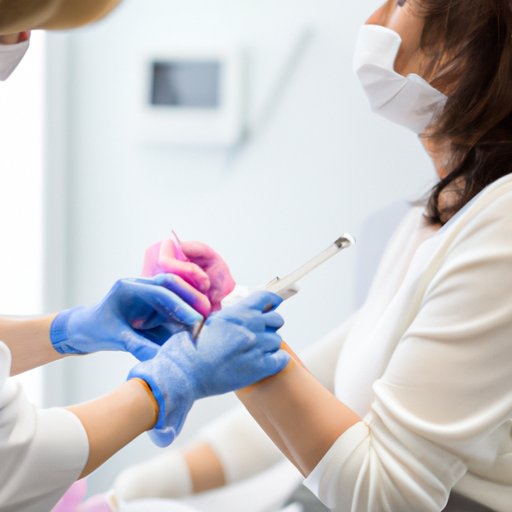Introduction
A Pap smear, also known as a Pap test, is a routine screening procedure performed by gynecologists to detect any abnormal changes in the cells of the cervix. The cervix is the lower, narrow end of the uterus that opens into the vagina. The purpose of the Pap smear is to find any precancerous or cancerous cells that may be present in the cervix. It is one of the most effective methods for detecting cervical cancer in its early stages, when it is most treatable.
Step-By-Step Guide to Pap Smear Procedures
A Pap smear is relatively quick and painless. Here is a step-by-step guide to the procedure:
Preparing for the Pap Smear
Before the Pap smear, your doctor will ask you questions about your medical history and perform a pelvic exam. Your doctor may also take a sample of fluid from your cervix to check for any signs of infection. It is important to tell your doctor if you are pregnant or have recently had any sexually transmitted infections (STIs).
The Procedure Itself
During the Pap smear, your doctor will use a speculum to open your vagina and then use a soft brush or spatula to gently collect a sample of cells from the surface of your cervix. This sample is placed on a glass slide and sent to a lab for analysis. The entire procedure usually takes only a few minutes.
Follow-Up Care
If your Pap smear results come back normal, your doctor will likely recommend repeating the test every three years. If the results show any abnormalities, your doctor may recommend further testing or treatment. In most cases, these treatments are simple and can help prevent cervical cancer.

Common Questions Patients Have About Pap Smears
Many patients have questions about Pap smears. Here are some of the most common questions and their answers:
What is the Difference Between a Pap Smear and an HPV Test?
A Pap smear is a screening test that looks for abnormal cells on the cervix. An HPV test looks for the human papillomavirus (HPV), which is a sexually transmitted virus that can cause cervical cancer. Both tests are recommended for women over the age of 30.
Is a Pap Smear Painful?
Most women don’t find the Pap smear uncomfortable. Some women may experience slight discomfort or cramping during the procedure. Your doctor can provide medication to help reduce any discomfort.
How Often Should I Get a Pap Smear?
The American College of Obstetricians and Gynecologists recommends that women between the ages of 21 and 29 get a Pap smear every three years. Women between the ages of 30 and 65 should get a Pap smear and an HPV test every five years. Women over the age of 65 who have had regular Pap smears with normal results can stop having them.

How a Pap Smear is Used to Detect Cervical Cancer
The cells collected during a Pap smear are examined under a microscope to look for any abnormal changes. The cells are classified according to the Bethesda System, which is a standardized system used to assess cell changes. There are five categories, ranging from normal to severely abnormal.
Types of Cells Inspected
The cells inspected during a Pap smear include squamous cells, which line the cervix; glandular cells, which produce mucus; and metaplastic cells, which are abnormal cells that may be precancerous.
Abnormal Results
If the Pap smear reveals any abnormal cells, your doctor may recommend further testing. These tests may include a biopsy, colposcopy, or HPV test. These tests can help determine if the abnormal cells are cancerous or precancerous.
Understanding the Process of Getting a Pap Smear
Undergoing a Pap smear is a simple and straightforward process. Here are the steps involved:
Scheduling Your Appointment
Your first step is to make an appointment with your gynecologist. You should plan for the visit to take about an hour, including the time for paperwork and discussion with your doctor.
Preparing for Your Visit
Before your visit, you should avoid douching, using tampons, having sex, or using any vaginal creams or medications. You should also drink plenty of water to make sure you have a full bladder, which makes it easier for your doctor to perform the Pap smear.
During the Exam
During the exam, your doctor will use a speculum to open your vagina and then use a brush or spatula to collect a sample of cells from your cervix. The sample is then placed on a glass slide and sent to a lab for analysis.
After the Exam
After the exam, you may experience some light spotting or cramping. This is normal and should go away within a few days. You will receive your results within two weeks. If the results are abnormal, your doctor may recommend further testing.
Conclusion
Pap smears are an important screening tool for detecting cervical cancer in its early stages. The procedure is relatively quick and painless, and it can help detect any abnormal cells that may indicate the presence of precancerous or cancerous cells. It is recommended that women between the ages of 21 and 29 get a Pap smear every three years, and women between the ages of 30 and 65 get both a Pap smear and an HPV test every five years. By understanding the process and importance of getting regular Pap smears, women can protect themselves from cervical cancer.
(Note: Is this article not meeting your expectations? Do you have knowledge or insights to share? Unlock new opportunities and expand your reach by joining our authors team. Click Registration to join us and share your expertise with our readers.)
